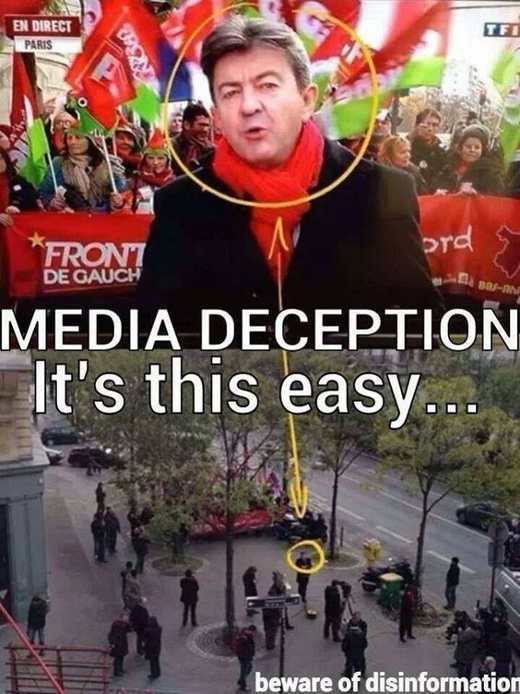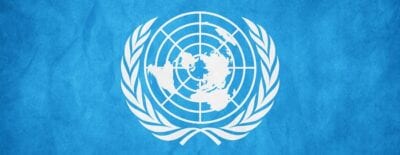The corporate/commercially controlled media (CCM), also termed big media, old media or (misleadingly) mainstream media (MSM) is a set of corporations whose main output will be familiar to most, i.e. BBC, CNN, Washington Post, New York Times etc. (Wikispooks) The common denominator of the “mainstream media” (at times referred to as the lamestream media for satirical purposes) is their censoring or downplaying stories that would lead viewers to conservative conclusions, and their use of photo bias, placement bias and other forms of deception to mislead viewers into drawing incorrect liberal conclusions. The term mainstream media usually refers to how the majority of commercial-based or taxpayer-funded news reporting and commentary consist of liberal bias, while falsely pretending to be objective providers of information. In addition to promoting forms of censorship, the mainstream media has increasingly promoted or condoned the violence of the Antifa and other left-wingers. (Conservapedia)
Echoing the official narrative of its more highly funded, longer established bedfellows, Wikipedia refers to the large news conglomerates with their preferred self-description, the “mainstream media” (MSM). As of January 2017, the Wikipedia page had lead for some years with a reference to a 1997 article by Noam Chomsky, stating that “Mainstream Media” (MSM) “both reflect and shape prevailing currents of thought”. This is an uncomfortable fit with a September 2016 poll finding that found only 32% of US adults trusting big media “to report the news fully, accurately and fairly.” (Wikispooks)
Wikipedia experienced a professionalization around 2007 which moved it firmly in the direction of the commercially controlled media. This is most clearly understood through the “Reliable Sources” policy in particular which means, more or less, that if a subject hasn’t been reported on by commercially controlled media or by those in established positions of social power and influence, then Wikipedia doesn’t want to know about it. These policies do in fact lead to a credible and useful encyclopaedia on whole swathe of topics (i.e. technical, non-political topics) no doubt giving many readers the misleading impression that Wikipedia articles are reliable even for politically sensitive topics.
In 1987, the Federal Communications Commission voted 4-0 to revoke the Fairness Doctrine. The Fairness Doctrine mandated that if any opinion considered “controversial” were ever discussed on the public airwaves, the station over which that opinion aired was required to give equal time to any person wishing to reply. However, the FCC never set a standard about interpretations of current events that might be disputable, or even examined that issue. With the revocation of the Fairness Doctrine, radio and television stations were now permitted to air any opinion or interpretation of the news, no matter how “controversial,” without regard to the giving of “equal time.” (Conservapedia)
In 2005 the case of Steve Wilson and Jane Akre set an important legal precedent. They were fired when they refused to tailor their investigation into RBGH to suit Monsanto‘s wishes. Ruling on their case, a Florida Court of Appeals unanimously agreed that their employer could demand that they lie since there is no rule against distorting or falsifying the news in the United States. An uncertain but large proportion (perhaps >50%) of TV news footage in USA is in fact VNRs (video news releases) produced by 3rd party corporations, as a kind of stealth advertisement masquerading as news. (Wikispooks)
Censorship
Daniel Ellsberg says that the White House has ordered the press not to cover the revelations of Sibel Edmonds:
“I am confident that there is conversation inside the Government as to ‘How do we deal with Sibel [Edmonds]? The first line of defense is to ensure that she doesn’t get into the [corporate] media. I think any outlet that thought of using her materials would go to to the government and they would be told “don’t touch this…”” – Daniel Ellsberg (2014)
Western Mainstream media impose a huge burden of fake news on Western societies through entrenched and pervasive lying by omission. Indeed the most egregious and pervasive Mainstream media lie of omission is suppression of reportage of such lying by omission. The unimpeded, remorseless, corporate-dominated Mainstream media, politicians and pliant intellectuals are now going further, and variously threatening residual effective free speech and Alternative media on the basis of asserted fake news. (source)
Internet censorship is of necessity more complex and varied where many users can post. Covert censorship is generally preferred, but sometimes overt censorship is resorted to. Wikipedia has its own censorship practices. Reddit is subject to censorship and control. In November 2016 Reddit banned a group which was investigating top level pedophilia in US society to prevent a “witch hunt“. The group continued their investigate at voat.co, an alternative platform not owned by Conde Nast. The group has compiled a list of dozens of corporate media outlets which removed related content.
The sudden about face of the UK’s best selling newspaper, the Sunday Times as regards Sibel Edmonds could be likened to that of the San Jose Mercury News after Gary Webb revealed the CIA’s deep involvement in drug trafficking. Both papers, after initially carrying out their own research to verify the information, backed their source’s extraordinary revelations. Both however sudden reversed their policy without providing an explanation.
“[The] investigation based on Edmonds’ information was supposed to have four parts, but was inexplicably dropped. “The story was pulled half-way, suddenly, without any warning”, the journalist said. “I wasn’t party to the editorial decision to drop the story, but there was a belief in the office amongst several journalists who were part of the Insight investigative unit that the decision was made under pressure from the U.S. State Department, because the story might cause a diplomatic incident… The way the story was dropped was unusual, but the belief amongst my colleagues this happened under political pressure is plausible.” He cryptically described an “editorial mechanism, linked to the paper but not formally part of it, which could however exert control on stories when necessary, linked to certain interests.” When asked which interests, the journalist said, “I can’t say. I can’t talk about that.”” – An unnamed “lead reporter” on Edwards’ series at the Sunday Times. (January 2008)
Propaganda
In their book Manufacturing Consent – The Political Economy of the Mass Media (Pantheon, 1988), Edward Herman and Noam Chomsky set out their “propaganda model of media control”. In a subsequent article written in 1996, Edward Herman explains the genesis of the model:
“We had long been impressed with the regularity with which the media operate within restricted assumptions, depend heavily and uncritically on elite information sources, and participate in propaganda campaigns helpful to elite interests. In trying to explain why they do this we looked for structural factors as the only possible root of systematic behavior and performance patterns.”
In identifying these “structural factors”, Herman and Chomsky list five news “filters” through which “money and power are able to filter out the news fit to print, marginalize dissent, and allow the government and dominant private interests to get their messages across to the public”.
- the size, concentrated ownership, owner wealth, and profit orientation of the dominant mass-media firms
- advertising as the primary income source of the mass media
- the reliance of the media on information provided by government, business, and “experts” funded and approved by these primary sources and agents of power
- “flak” as a means of disciplining the media
- “anticommunism” (more recently, “anti-terrorism”) as a national religion and control mechanism.
Herman adds some flesh to the bones:
“The crucial structural factors derive from the fact that the dominant media are firmly imbedded in the market system. They are profit-seeking businesses, owned by very wealthy people (or other companies); they are funded largely by advertisers who are also profit-seeking entities, and who want their ads to appear in a supportive selling environment. The media are also dependent on government and major business firms as information sources, and both efficiency and political considerations, and frequently overlapping interests, cause a certain degree of solidarity to prevail among the government, major media, and other corporate businesses.
“Government and large non-media business firms are also best positioned (and sufficiently wealthy) to be able to pressure the media with threats of withdrawal of advertising or TV licenses, libel suits, and other direct and indirect modes of attack. The media are also constrained by the dominant ideology, which heavily featured anticommunism before and during the Cold War era, and was mobilized often to prevent the media from criticizing attacks on small states labelled communist.
“These factors are linked together, reflecting the multi-levelled capability of powerful business and government entities and collectives (e.g., the Business Roundtable; U.S. Chamber of Commerce; industry lobbies and front groups) to exert power over the flow of information.”
Notice that the propaganda model is not a ‘conspiracy theory’. Herman and Chomsky write:
“We do not use any kind of conspiracy hypothesis to explain mass media performance. Our treatment is much closer to a free market analysis, with the results largely an outcome of the workings of market forces.”
The media-industrial complex/media-entertainment complex is not a conspiracy theory. The trail of influence and money which both directly and indirectly weighs on the content put out by Hollywood and the US mainstream media is very real. It is both historical fact and sadly it is also part of the present reality.
Operation Mockingbird was a CIA initiative wherein US journalists at organizations like the New York Times and CBS were fed propaganda stories to send out to their then virtually monopolized share of American readers and viewers. Many journalists were paid by the CIA to promote such stories. In other cases, naive journalists were simply given the information and put it out as real news, when in fact it was what today we would call ‘fake news’.
Dr. Udo Ulfkotte, a prominent German journalist and editor for more than two decades, is one example of how the CIA. He blew the whistle on public television, stating that he was forced to publish the works of intelligence agencies under his own name and that noncompliance with these orders would result in him losing his job. (source)
An article on GlobalResearch.ca titled The Lie of the 21st Century: How Mainstream Media “Fake News” Led to the U.S. Invasion of Iraq, says: “The MSM has lost its credibility and at the same time lost viewers at unprecedented levels. on April 17, 2016, the Associated Press reported on how the U.S. population viewed the MSM ‘Poll: Getting facts right key to Americans’ trust in media’ said that “Just 6 percent of people say they have a lot of confidence in the media, putting the news industry about equal to Congress and well below the public’s view of other institutions.” Now they want to stop the alternative media from becoming a credible source for news. The New York Times is calling for the censorship of the alternative and social media by blocking “misinformation”:
Blocking misinformation will help protect the company’s brand and credibility. Some platforms have suffered when they have failed to address users’ concerns. Twitter users, for instance, have backed away from that platform because of abusive trolling, threatening posts and hate speech, which the company hasn’t been able to control.
Mr. Zuckerberg himself has spoken at length about how social media can help improve society. In a 2012 letter to investors, he said it could “bring a more honest and transparent dialogue around government that could lead to more direct empowerment of people, more accountability for officials and better solutions to some of the biggest problems of our time.” None of that will happen if he continues to let liars and con artists hijack his platform.
The audience of several corporate media companies (such as MSNBC, Fox News and CNN) declined significantly in 2013 suggesting that viewers were going elsewhere for information. The main alternative to the corporate media is the internet, where a multiplicity of smaller sources (such as Wikispooks, HistoryBud, Infowars, etc.) provide an alternative to the online corporate news sites. One response to this has been to ramp up propaganda about “cyberterrorism” and to expand internet censorship under pretexts such as the “war on terror” or the protection of “intellectual property“.
Sharyl Attkisson and Amber Lyon, both well-known mainstream media reporters and journalists, have also exposed funded movements by political, corporate, and other special interests, and have revealed that they are routinely paid by the U.S. government as well as foreign governments to selectively report and distort information on certain events. (source)(source)
A recently declassified document from the CIA archives in the form of a letter from a CIA task force addressed to the Director of the Central Intelligence Agency details the close relationship that exists between the CIA and mainstream media and academia.
The document states that the CIA task force “now has relationships with reporters from every major wire service, newspaper, news weekly, and television network in the nation,” and that “this has helped us turn some ‘intelligence failure’ stories into ‘intelligence success” stories,’ and has contributed to the accuracy of countless others.” Furthermore, it explains how the agency has “persuaded reporters to postpone, change, hold, or even scrap stories that could have adversely affected national security interests or jeopardized sources and methods.”
The document not only outlines the CIA’s role in media, but also the entire entertainment industry in general, lending further weight to revelations offered by celebrities like Jim Carrey. He appeared as a guest on Jimmy Kimmel Live, saying that, “For years now, talk show hosts, people on television, people in sitcoms have been, hired by the government to throw you off the tracks, to distract you, to make you laugh and stuff like that, make you happy and docile so you don’t know what’s really going on.”
What we seem to have here is an attempt to manipulate public perception of global events through mainstream media and news publications. But what’s perhaps most interesting is the fact that a lot of people are now waking up and seeing through many of these lies and manipulation tactics. Instead of just blindly believing what we hear on television, more people are starting to think critically, do independent research, and examine a wide array of sources and information.
Media Monopoly?
Back in 1983, 50 corporations controlled most of the American media, but by 1992 the number had dropped by half, and by 2000 there were left only 5 corporations wielding totalitarian control over the media. Their control covers all the means for expression of speech and ideas: television, movies, radio, books, music, news feeds. Those figures refer to everything except for print media, newspapers and magazines, which would add a couple of more oligarchs to the small group of media controlling owners. Some of the Big Five media corporations are in themselves also print media owners.
Ownership in general in the United States of all America’s major corporations has been concentrated in incredibly few hands. To make matters worse, those business corporations (in themselves oligopolies) are as a rule owned by the same set of investors, which in turn are cross-owned by each other (oligopolistic investors). There then is a situation where oligopolies own oligopolies.
What was said above about the extreme concentration of ownership obviously also holds true for the media (including print). I reported there that institutional investors like BlackRock, Vanguard, State Street, Fidelity, and JP Morgan, now own 80% of all stock in S&P 500 listed companies. The Big Three investors – BlackRock, Vanguard and State Street – alone constitute the largest shareholder in 88% of S&P 500 firms, which roughly correspond to America’s 500 largest corporations. (*1). Both BlackRock and Vanguard are among the top five shareholders of almost 70% of America’s largest 2,000 publicly traded corporations. These same institutional investors largely control the media, television, film, publishing, telecommunications and Internet, as it will be shown below. (*2).
In media there is therefore ultimately the situation that just a few persons hold the power over the entire media. We do not have the means to untangle the whole web of control connections to get to the ultimate few. However, what is presented here should be damning enough. This report shows beyond any doubt that an incredibly small group of oligarchs have amassed all the most important media assets in the United States. Whether the ultimate owners are a yet smaller group than it would seem at this first glance does not alter the picture to any significant degree. What is clear is that just a few oligarchs now have the means to exercise a totalitarian control over speech and ideas in the United States (and increasingly globally, too). In this connection, I will not digress into a substantial discussion of how this totalitarian control manifests itself. For now suffice to allude to the multitude of instances when the media has through systematic campaigns of propaganda for war coerced the political leaders to declare wars (or to wage undeclared wars): Iraq, Libya, Syria, to mention just a few relatively recent ones.
The continuous vilification of Russia’s President Putin and Russia as a nation is another of their campaigns of war propaganda. More recently, similar patterns of vilification have been extended to the treatment of China and its President Xi. The Russia hoax, that is, the attempted coup against US President Trump by alleging his election campaign colluded with Russia, was founded in totalitarian media lies. Other examples of agendas that the media pursue by way of abusing their monopoly on expression include a one-sided fact-free propagation of climate change alarmism and gender identity politics to the extent of denying obvious biological facts. These were but a few examples of the totally agenda-driven reporting by the concentrated oligarch media. In an article where he maintains that “America is a dictatorship by its super-rich,” American writer and investigative historian Eric Zuesse maintains that the US regime has elevated propaganda lies to the role of primary means of coercion, obviously seconded by its ample use of violence both domestically and around the globe. It is through this incredible concentration of media that the regime has achieved a virtual monopoly on lies, which it employs to justify and varnish that violence.
The biggest media owners are Comcast, The Walt Disney Company, the oligarch Rupert Murdoch, with News Corp and Fox Corporation, the oligarch Sumner Redstone via his National Amusements Inc., which holds both Viacom Inc., CBS Corporation, and Warner Media (owned by AT&T),
Comcast – a former General Electric subsidiary – owns among other assets NBC and the British based Sky TV. It provides consumer cable television, telephone, internet, and wireless services under the brand name Xfinity. Comcast is America’s largest provider of cable internet access servicing 40% of the market. The film studio Universal Pictures (aka Universal Studios) is a NBC subsidiary. The major shareholders of Comcast are listed in below table. (The shareholder data in this and other tables are sourced, when other source not mentioned, from www.stockzoa.com).

The Walt Disney Company is the world’s largest media conglomerate in terms of revenue. It’s original asset is the Walt Disney Studios and Disney theme parks. Over the years it has added on among others, Pixar, Marvel Studios, Lucasfilm, 20th Century Fox, ABC broadcast network, ESPN, National Geographic network, and several other cable TVs. Disney like all the other media oligopolists are also involved in publishing and many other fields of business. Walt Disney acquired the Fox Entertainment Group (including 20th Century Fox film studio) and National Geographic Partners from 21st Century Fox which had come to being after News Corporation was split in 2013.
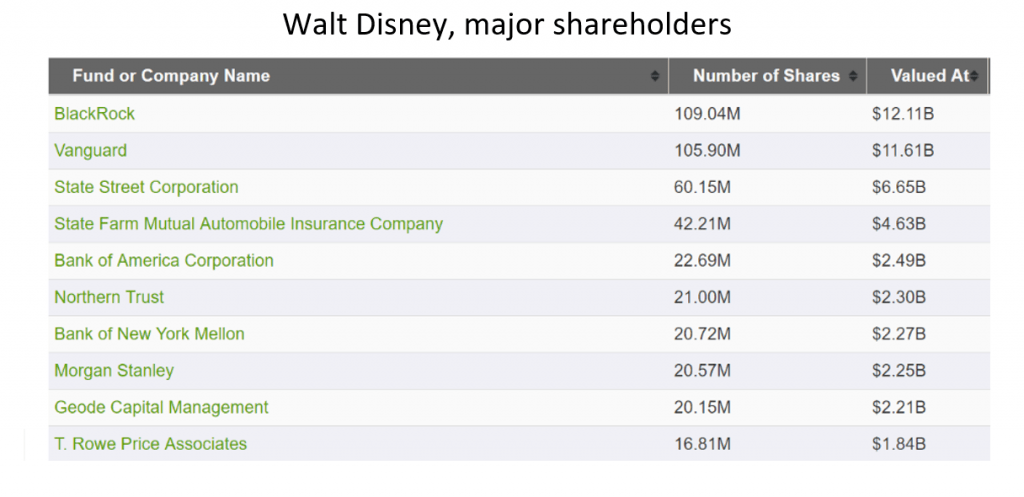
In connection with the split of the original News Corporation and the sale of above mentioned assets to Walt Disney, two other companies emerged. These are Fox Corporation and the new News Corp, both controlled by the media tycoon Rupert Murdoch. Fox Corporations owns the Fox Broadcasting Company, Fox Television Stations, and Fox News. The assets of News Corp include Dow Jones & Company (publisher of The Wall Street Journal, The New York Post, News UK (publisher of The Sun and The Times), News Corp Australia, Realtor.com and HarperCollins.
Viacom Inc. and CBS Corporation are both controlled by the oligarch Sumner Redstone through his National Amusements Inc. Redstone has cemented his control of those corporations through an arrangement where the oligarch owns the so-called Class A or voting shares whereas the other investors keep the Class B common stock, whose voting rights are severely curtailed. As of December 2016, National Amusements (and it’s not funny), directly and through subsidiaries, held 79.8% of the Class A voting shares of Viacom Inc., corresponding to only 10% of the overall equity. In CBS Corporations, National Amusements, held 79.5% of the Class A voting shares and 2.4% of the Class B non‐voting shares, which constituted 9.1% of the overall equity.
In the case of Viacom, Redstone’s National Amusements holds 10% of the total equity by which he wields control over the resting 90%. In CBS Corporation National Amusement controls the company with 9% of total equity.
Viacom consists of Viacom Media Networks (owner of MTV) and Paramount Pictures and operates approximately 170 networks reaching 700 million subscribers in 160 countries.
CBS Corporation operates television broadcasting stations (CBS and CW), TV production and distribution, publishing (Simon & Schuster), cable TV and recording operations.
Warner Media is currently owned by AT&T. The company has film, television, cable and publishing operations. It owns CNN and the Cartoon Network. Its assets include also Warner Bros. one of the major film producers with also television and video games; HBO cable and satellite TV operations with 130 million subscribers.

AT&T is also the largest American telecommunications company and second largest provider of mobile telephone (wireless telecommunication) services after Verizon.
What about print media
Some of the major print media outlets – newspapers, magazines and their digital sites – are still held outside the above listed media conglomerates. To some extent their controlling shareholders are another set of oligarchs while they also are cross-owned by the same oligarchs as above.
After its acquisition of Time Inc. in 2018, Meredith Corporation became the largest print media publisher with assets including a multitude of magazines with a readership of more than 120 million, paid circulation being 40 million copies. It also operates 15 television stations which reach 11% of American households. After everything we already reported, the ownership structure of Meredith Corporation should not surprise anybody, as per below chart.
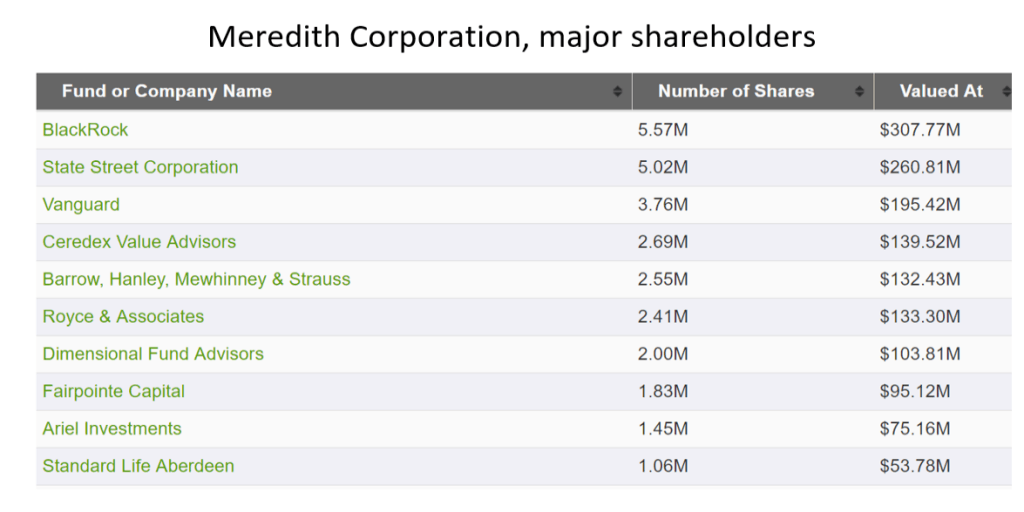
The second largest American newspaper publisher is Gannett Co., Inc. It’s portfolio includes USA Today and a number of regional newspapers. The company is publicly traded and owned by the oligarchy’s institutional investors.
Among the top 4 print media publishers are also McClatchy Company operating 29 daily newspapers in fourteen states, and the Tribune Publishing Company, the publisher of the Chicago Tribune and many regional and local newspapers. McClatchy Company is owned by Comcast, AT&T, major oligarchy banks and the usual suspects of institutional investors: BlackRock, Goldman Sachs, JP Morgan etc. Tribune is held by the business magnate Michael W. Ferro.
The New York Times is owned by the same line up of the US oligarchy.

The other of America’s major newspapers have been assigned to the care of individual members of the US oligarchy. Time magazine – with the world’s largest news magazine circulation – is held by Marc Benioff. The Washington Post has been parked with the Amazon oligarch Jeff Bezos. The Los Angeles Times is owned by tycoon Patrick Soon-Shiong.
News agencies
To add to the already dismal picture of media concentration, we must also realize that most of American media – and Western media in general (increasingly the whole world) – rely heavily on newsfeeds coming from only three news agencies with a global presence. These are Associated Press (AP, USA), Reuters (UK), Agence France-Press (AFP, France).
Associated Press is structured as a not-for-profit organization directly controlled by the already listed media conglomerates. Reuters is owned by Thomson Reuters Corporation, which is ultimately owned by the Canadian oligarch Thomson family. AFP is nominally owned by the French state but it operates as a commercial business with strong neoliberal leanings.
In economy and business news a substantial source is also Bloomberg L.P. owned by the oligarch Michael Bloomberg.
In the old days with much more media plurality, the more solid newspapers would employ a vast network of overseas correspondents. Many of them where in-house journalists organized as the paper’s foreign bureaus. In the old times, by having access to the reporting of a vast number of journalist representing competing media outlets and different ideologies, active readers could stay well-informed about global events. But during the last two decades, most media outlets have dramataically cut down on their overseas staff. This has been driven by cost-cutting efforts and has also come as an inherent consequence of the concentration, the oligarch owners have figured they do not need separate bureaus for the different media outlets they own. I assume that the reasons are even more sinister than those and infer that the large scale reduction has happened in conspiracy between the media controlling oligarchs as a means to facilitate propaganda: the less correspondents out there in the wide world, the less the risk that the truth about global affairs would slip out potentially ruining the carefully crafted propaganda narratives. For this purpose it is much better to have global reporting concentrated in the hands of the three agencies and State Department officials. (The flip side of this is however that there are less opportunities to post intelligence agents abroad under the cover of journalists).
A Washington Post blogger reported that the American Journalism review had in 2011 exposed that 18 of the major US newspapers had closed every one of their foreign bureaus over the preceding 12 years. The same source told that most of the remaining “bureaus” in fact only consisted of a single journalist posted abroad. (Even more likely that nobody was “posted abroad” and that the newspaper only relied on locally based freelancers).
The harrowing outcome of all this is that the typical modern-day citizen consumer of media reporting has less access to the truth than one would have had a hundred years ago. This is truly mind gobbling when we consider our today’s extensive networks of affordable air transportation and the enormous opportunities for exchange of information offered by online technology. Only those who are willing to invest their time in finding out the real state of affairs through alternative Internet based information resources can possible stay neutrally informed. This is precisely why those in power have moved so forcefully against dissident sources on the Internet. They are adamant to patch up that crack in the propaganda wall.
Cable and wireless
The wireless communication service and cable internet providers are the gatekeepers to the Internet. And they are all also owned by the oligarchy. Although they – in their roles as Internet providers – do not produce content, they carry content and communication. (We must also keep in mind that these corporations are largely cross-owned by the same set of oligarchs.) The problem is that in this capacity they tend to interfere with that and discriminate against content and communication they do not like, by blocking, or by charging more, or by slowing down the traffic they do not like. Some providers have openly stated that as their policy, some are doing it without acknowledging it, many have been caught, and then denied. The fact is that they do interfere and the worst is that this tight knit-class of oligarchs have a means to interfere on this severely concentrated market at their will when the urge emerges. In addition to interference on political grounds, these internet providers also give preferences to some business clients and penalize others in service packages that distort competition. All the internet service providers are also known to willingly share all client data and communication with the US spy agencies, most notably the National Security Agency (NAS) and the CIA without even a simulacrum of legality and due process.
The top 4 wireless telecommunication providers (2018) are:
- Verizon, 9 million subscribers
- AT&T, 153.0 million
- T-Mobile, 79,7 million (owned by the German Deutsche Telekom)
- Sprint Corporation, 53.5 million
Below the Verizon ownership table. AT&T was already presented above. T-Mobile is owned by the German Deutsche Telekom and Sprint by Japanese SoftBank.

The companies that control the cable internet market are AT&T, Comcast (Xfinity), Charter Communications (Spectrum, Optimum), Verizon, CenturyLink. Most of these oligarch structures are already known to us from above. Below we give the charts for the two not presented above, Charter Communications and CenturyLink.
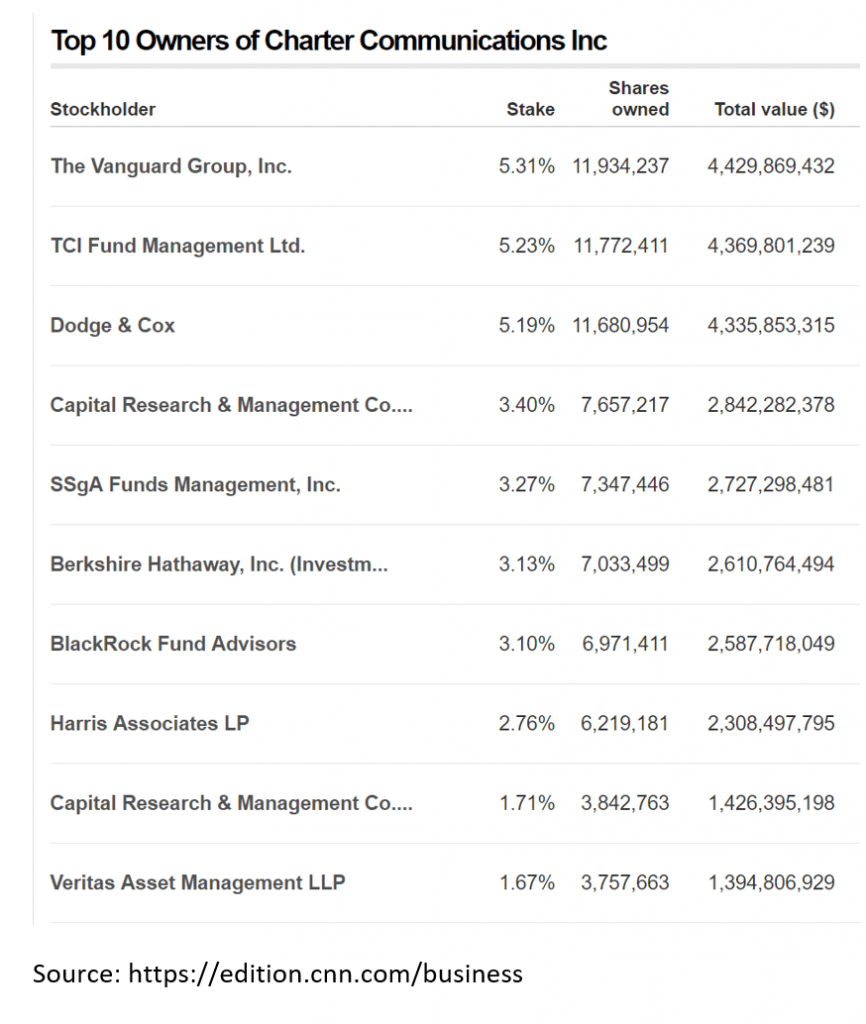
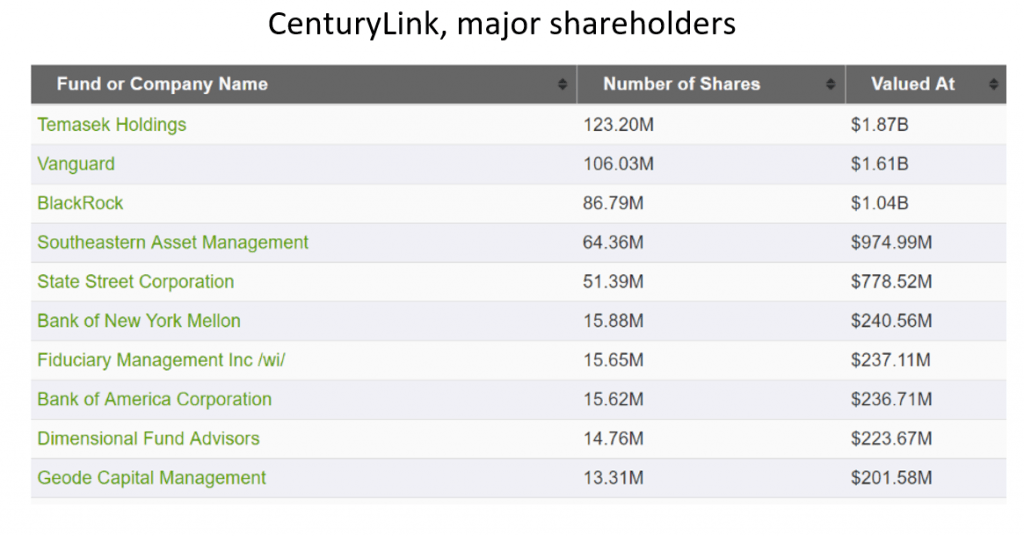
After its 2016 acquisition of Time Warner’s cable divisions, Charter Communications and Comcast have gained a virtual duopoly of the broadband market of 25Mbps and more, the two Internet service providers could control about 70 percent of the nation’s 25Mbps-and-up broadband subscriptions.
Continued on next page…


